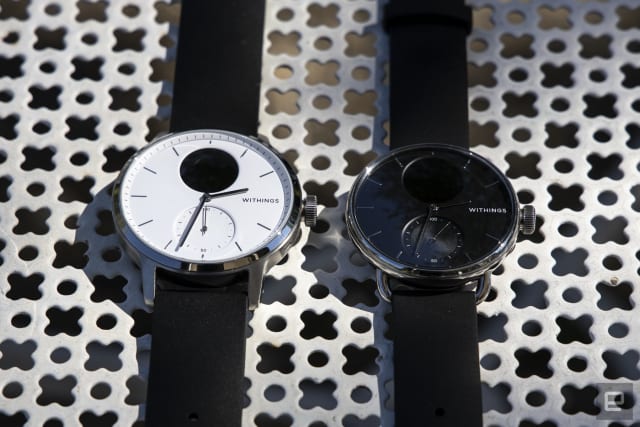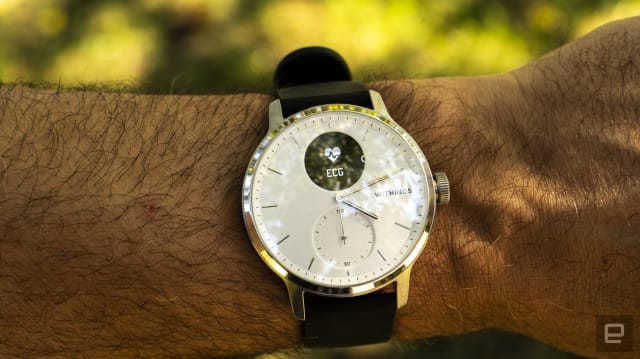Withings’ ScanWatch is the best hybrid smartwatch I’ve tried so far
As I wrote last year, there aren’t very many fitness tracking technologies that you can cram into a watch. When you have activity tracking, heart-rate and ECG monitors on board, the best you can aim for is refinements. Work is being done on ways of using optical sensors to monitor blood sugar or food intake, but that’s nowhere near ready for prime time.

Steve Dent
I’m in two minds about its design. The larger, 42mm model is wonderfully austere, with thick lugs and a subtle beveled edge. On the other hand, there’s a whiff of trying too hard, like those fake diver’s watches that cost $20. The smaller, 38mm version is far softer, with a narrower frame and rounded lugs that blend far better into the background. For both case sizes, you can opt for a white or black face, although the 42mm black model has a red subdial hand.
There are two subdials on the ScanWatch. The lower one is the patented analog activity dial that features on every Withings hybrid. As before, it counts from one to one hundred, it works up to the total you set for yourself in the companion app. If you’re looking to keep an eye on your activity but want to avoid unnecessary screens, this is ideal.
The second sundial, up top, is the rounded PMOLED display that will show you smart notifications and let you access the watch’s special features. Push the crown in, and you can cycle through menus that show your heart rate, steps taken, distance traveled and floors climbed. You’ll also be able to trigger an ECG (Electrocardiogram) and an SpO2 (blood oxygen saturation) test.
Both are relatively easy to perform, you just have to sit/stand still and lay your hands on a surface, with a finger resting on the bezel for an ECG. I think it’s more elegant and reliable than the Move ECG, which required you to pinch the watch face on both sides like a battery tester. And watching the readout on the small display helps you to see how your heart is doing.

Steve Dent
Naturally, all Withings products lean heavily on Health Mate, one of the better health companion apps available. It breaks down your health into a daily dashboard and collates your longer-term data to give you a wide-ranging picture of your progress (or lack thereof) over time. I also have a soft spot for how the app tells you when you’ve traveled the length of a major landmark — like crossing Madagascar.
Having said all that, I think the ScanWatch is too expensive for a hybrid, despite all these features. In the US, the larger model will set you back $300, the sort of money you could spend on a flagship smartwatch. If you want an alternative to the Apple and Samsung watches of this world, then this is one of your best options, but I wish it was $50 cheaper.
Withings says that the ScanWatch’s battery will last for up to 30 days on a charge, and it comes with a pogo-pin charging plate in the case. In the few days I’ve had to test it, I’ve barely made a dent into the cell, even with repeated ECG and blood oxygenation tests.
Withings ScanWatch is available today in Europe, priced at €280/£250 in for the 38mm edition and €299/£280 for the 42mm body. It’ll be available in the US when the FDA clears it, and will set you back $280 / $300 for the 38mm/42mm versions.
Steve Dent contributed to this report.
All products recommended by Engadget are selected by our editorial team, independent of our parent company. Some of our stories include affiliate links. If you buy something through one of these links, we may earn an affiliate commission.
Source:Engadget



